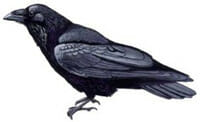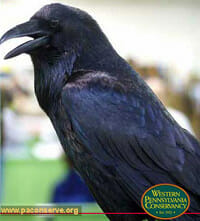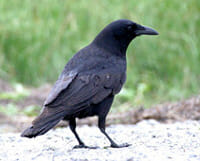Northen (Common) Raven – Passeriformes Corvidae Corvus corax
 |
 |
 |
Identification & Description:
• Very large crow.
• Entirely black plumage
• Larger than crows
• Wedge-shaped tail
• Relatively short legs
• Size: 56-69 cm (22-27 in)
• Wingspan: 116-118 cm (46-46 in)
• Weight: 689-1625 g (24.32-57.36 ounces)
Similar species:
Crows are smaller, have squared-off tails and different calls. Chihuahuan Raven similar but smaller with somewhat different calls and occupies more arid habitats.
Life History Groupings
• Migration Status: Permanent resident
• Nest Location: Mid-story/canopy nesting
• Clutch Size :3-7
• Length of Incubation: 18-21 days
• Days to Fledge: 38-44
• Number of Broods: 1
• Diet:
Primarily: Carrion
Lesser Quantities of: Reptiles or Amphibians, Eggs, Insects & Plant Matter
Facts
• The Common Raven is an acrobatic flier. It frequently is seen to make rolls and somersaults in the air. It has even been observed flying upside down for as far as one kilometer (0.62 mi).
• Breeding pairs of Common Ravens hold territories and try to exclude all other ravens throughout the year. In winter, young ravens finding a carcass will call other ravens to the prize. They apparently do this to overwhelm the local territory owners by force of numbers to gain access to the food.
• The Common Raven often uses sheep wool to line its nest. When the female leaves the nest for a while she may cover the eggs with the wool.
• Increasing raven populations can have significant negative effects on the populations of some vulnerable prey species, such as desert tortoises and Least Terns. Ravens can cause trouble for people too. Ravens have been implicated in causing power outages by contaminating insulators on power lines, fouling satellite dishes at the Goldstone Deep Space Site, peeling radar absorbent material off buildings at the Chinal Lake Naval Weapons center, pecking holes in airplane wings, and stealing golf balls.
Other Names
Grand corbeau (French)
Cuervo cumún, Cuervo grande (Spanish)
Ravens belong to the family Corvidae of the order Passeriformes. The common raven is classified as Corvus corax, the brown-necked raven as Corvus ruficollis, and the Chihuahuan raven as Corvus cryptoleucus.
Raven, common name applied to about ten large birds of the crow family. Best known is the common raven, found throughout much of the northern hemisphere, from the high Arctic islands of Canada to the deserts of North Africa. It is the largest of all songbirds (see Passerine), attaining a length of more than 60 cm (more than 24 in). Because the bird is intelligent, social, and highly adaptable, it has long been a subject of legend and folklore. It has a wedge-shaped tail and is satiny black, with a metallic, bluish sheen. The bill is long, powerful, and slightly hooked, and the feet are strong. The common raven is omnivorous, feeding on seeds, fruit, small birds and mammals, and even carrion. It nests on high trees or cliffs; the female lays four to eight spotted, light-blue eggs in a clutch, and both parents feed the young.
A closely related species, the aptly named brown-necked raven, inhabits North Africa east to the Middle East. The only other American species is the Chihuahuan raven, a smaller bird of Mexico and the southwestern United States. It has a slightly different voice, and the concealed bases of the neck feathers are white.